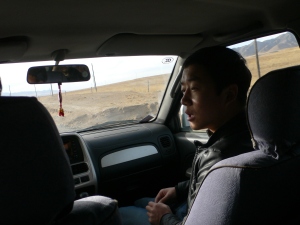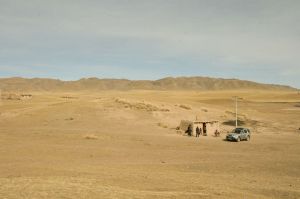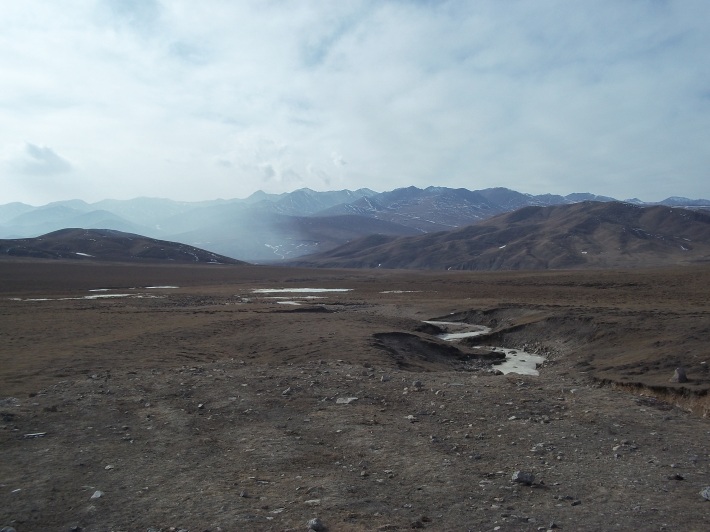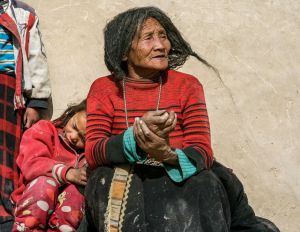The geographic center of the world’s most populous country sounds like a busy place. But if you stabbed a finger at the middle of a map of China, you would most likely find yourself pointing at a sparsely-populated region once known as Tibet. Today, Tibet lingers on officially only as the TAR (“Tibet Administrative Region”), while the rest is divided into the Chinese provinces of Qinghai, Sichuan, Gansu, and Yunnan. While urbanites in these provinces are, to some extent, riding the wave of China’s newfound affluence, farmers and nomads of the Tibetan Plateau, just a few kilometers away, inhabit a different world.
There, yak-herders eke out a living as they have for millennia, returning at night to mud huts with the approximate proportions of a walk-in closet. There is little infrastructure: the lone paved road, winding thousands of meters up and down mountains, inevitably gives way to rutted byways that connect three- and four-building “townships.” The region’s dismal schools are scattered at great intervals, and teachers have been known to show up drunk.
I recently visited the Amdo region of the Tibetan Plateau as part of my fellowship with the Shambala Foundation, an NGO that has been working to alleviate poverty in the region since 2006. At the Foundation’s modest headquarters in Xining, the capital of Qinghai Province, I met Chosyang Gorje and Choba Jeb, ethnic Tibetans who would be my drivers and guides.
“Craig” and “Ricky,” as they prefer to be called, braved the school system and emerged at the top of their respective classes. Their performance earned them free English training from ETP, another fixture of Qinghai’s NGO community. After six years’ study, the pair graduated in 2009. Within a few weeks, they had joined the Shambala Foundation as social workers. Today, at the age of twenty-two, they each earn 3,000 RMB per month.
Craig and Ricky are modest about what is, in point of fact, an enormous accomplishment: by finishing school, developing job skills, and landing stable, salaried positions with an international NGO, both young men have effectively lifted their families out of the poverty that gripped them for generations. At the same time, they signal to Amdo’s youngest generation that the obstacles arrayed against them can be overcome. In short, they represent the success story that the Shambala Foundation wants for each of its current 650 orphans.
* * * * *
 After a lunch of noodles, we piled into a van and began the four-hour drive to Seku County, where a handful of the Foundation’s orphans live with foster families. At first, the land sloped up and away from us on both sides, dotted with clusters of Han-Chinese graves and colossal electrical installations. But, as we drove further, the graves and electrical towers fell away, and the landscape became desolate, almost lunar. I thought of the badlands of Nevada.
After a lunch of noodles, we piled into a van and began the four-hour drive to Seku County, where a handful of the Foundation’s orphans live with foster families. At first, the land sloped up and away from us on both sides, dotted with clusters of Han-Chinese graves and colossal electrical installations. But, as we drove further, the graves and electrical towers fell away, and the landscape became desolate, almost lunar. I thought of the badlands of Nevada.
My guides cranked up the CD that was to be our soundtrack for the next four-and-a-half hours: Credence Clearwater Revival. Craig kept the mood up, flitting from one topic to another. “Movies,” he prompted. “I like ‘Forrest Gump.’ ‘Life is like a box of chocolates; you never know what you’re going to get’.” Words I never expected to hear on the Tibetan Plateau. Next, the inquisitive pair asked me to tell them “everything [I] know about the Holocaust” (another surprise), then, what I liked best about America. Sick of censorship after 14 months in China, I said freedom of speech, and returned the question.
Craig and Ricky professed strong attachment to Tibet’s traditional beliefs: reincarnation; wandering ghosts who possess if they aren’t trapped. I looked around: stuppas loomed over every hill, their tethers of bright prayer flags pinwheeling in all directions; the smoke- and dust-filled air of Xining behind us, the peaks on all sides were outlined in brilliant blue. It was easy to imagine spirits in the vicinity.
Our route took us up, then down into the Yellow River Valley, then precipitously up again onto the Plateau. In the relative comfort of the heated van, I was struck by the sheer distances in play. Townships were spaced thirty or forty minutes apart, with literally nothing in between. At last, with the sunlight slipping away, we entered Seku County and stopped in a puny township for more noodles and a Tibetan staple, mutton. Once outside the van, it was hard to notice anything but the searing cold air thick with smoke.
I had been warned about the cold at this altitude. While Xining is perched 2200 meters above sea level, this part of the Tibetan Plateau is closer to 4000. It’s enough to trigger headaches, nausea, and vomiting in some visitors. I had taken the precaution of wearing two pairs of long underwear, supplemented by a thermal top, sweater, overcoat, and hat and gloves that never came off. I needn’t have bothered. Even with the wind down, the cold cut right through my layers, leaving me shivering within seconds.
The smokiness, of course, is a simple consequence of people trying to survive here. Locals burn coal at a prodigious rate: when we finally reached the frigid guest house, an ayi promptly shuffled into our room with a big bucket of the stuff and began shoveling it into the small stove by the door. A fair amount of smoke trickled out of the vent pipe to hang heavily in our room. The poorest families rely on a free and abundant resource for heat: yak dung. It has the caloric content to keep a blaze going—but only if fed into the caste-iron stove non-stop. Essentially, families have to choose between sleeping or staying warm. As I lay in the guest house, fully clothed inside a sleeping bag and thick blankets, the Plateau struck me as a tough place to survive.
* * * * *
Apparently, famers and nomads agree with my assessment: an alarming proportion of Amdo children drop out of primary or middle school to support their families in any way they can—taking construction jobs, in the case of boys, or scavenging for “caterpillar fungus” prized by CTM practitioners. At high school age, dropout rates spike as new, higher school fees kick in.
This was the fate of Lhamo Tso, a twelve-year-old girl from Qinghai’s Gonghe County. Lhamo’s parents divorced when she was small and, starting new families, left her in her grandparents’ care. At the time, the elderly pair was living on less than 1000 RMB ($150) per year, much of it donated by neighbors. In theory, the government assists people like Lhamo’s grandparents through the Di Bao (public support) system—one “need” tier provides about 400 RMB / year; another provides 800. In reality, however, funds are released to often-unscrupulous village leaders, who divert them toward their own kin.
Lhamo’s grandparents tried their best to put her through school, where she showed tremendous promise. By some metrics, she was the top student in a school of three hundred. But the financial strain proved too great: the nearest school was kilometers away, which meant Lhamo would have to board; it closed for six days every month, which meant she would need transport there and back. Finally, although they are fully-funded and should be free, many schools in the area demand additional fees for books, meals, etc. In Lhamo’s case, these fees totaled 500 RMB—roughly half of her family’s yearly income. These factors alone would have spelled the end of Lhamo’s education. Then her grandfather fell ill, and his treatments plunged the family into debt. He passed away a few months later.
The Shambala Foundation was keen to help. Then came a report from one of its Gonghe social workers: unable to pay her creditors, Lhamo’s grandmother had reluctantly committed the little girl to an orphanage. She soon learned it was less of an orphanage and more of a cash cow: ownership uses its population of orphans to requisition ever-greater sums of government money, pocketing the majority while cutting corners on food, clothing, and care. Education is out of the question. When Lhamo’s grandmother, horrified, tried to get her back, she was referred to the contract she had signed; Lhamo will remain at the orphanage for three years, barring a 10,000 RMB contract “buy out.”
 The Communist Party, seeking to regulate life in these heretofore “Wild West” regions, is unwittingly making education even more unattainable for Tibetan children. The CCP is boarding up township schools and opening new ones far away in urban centers. Massive subsidized housing projects spring up around these urban schools, intended to lure farmers and nomads down from the Plateau. With greater resources and trained teachers, there is no question that the quality of education would be a step up. But no one has yet proposed a viable means for illiterate farmers and nomads to earn a living in an urban setting. Forced to choose between surviving on the Plateau and starving in the city, locals are staying put. Their children forego even the most basic education.
The Communist Party, seeking to regulate life in these heretofore “Wild West” regions, is unwittingly making education even more unattainable for Tibetan children. The CCP is boarding up township schools and opening new ones far away in urban centers. Massive subsidized housing projects spring up around these urban schools, intended to lure farmers and nomads down from the Plateau. With greater resources and trained teachers, there is no question that the quality of education would be a step up. But no one has yet proposed a viable means for illiterate farmers and nomads to earn a living in an urban setting. Forced to choose between surviving on the Plateau and starving in the city, locals are staying put. Their children forego even the most basic education.
In the farming and nomadic communities of Amdo, I gathered, education is viewed as a luxury. The trouble is, it’s not. Chinese society as a whole is surging ahead, while Amdo’s inhabitants—poorly positioned to begin with—fall further and further behind.
* * * * *
Morning brought with it the same astonishing cold. Outside our guest house Craig and Ricky, clad in ludicrously inadequate windbreakers, conferred in the white billow of their breath. To maximize time with the orphans, they agreed to split up. I would go with Ricky, in the van, in search of a little girl and her nomadic family a few miles to the north. As we drove, I quizzed Ricky on their background.
Tsomo never knew her father, who was what Tibetans call a “night visitor.” Her mother suffered from mental illness, leaving the child in the care of her octogenarian grandmother. When the Shambala Foundation learned of her case, in 2010, the family was living on about 800 RMB per year (just over $100). On his first visit, former SF social worker Sanggji Drolma found Tsomo filthy, malnourished, and sick. Without treatment, she was unlikely to live. Delicately, with what soothing words he could find, Sanggji had pried the little girl away from her grandmother and brought her to Xining for medical attention. With a healthy diet and supplements, the little girl recovered. She returned to the Plateau, and to school. With the Foundation’s support, Tsomo is alive and well—and about to finish 4th grade. If she keeps up her grades, she will receive Foundation scholarships to attend high school, vocational school, or even university.
The nomadic community was located several kilometers off the paved road. We moved at a snail’s pace, the van bucking and listing crazily to one side or the other as we traversed the wagon-way. Every few minutes, Ricky leapt from the van to peer at the scant offering of landmarks—a township; a stuppa; a solitary Tibetan burning incense—and beg his nomad contact for fresh directions. After an hour of off-roading, we came upon the red-faced nomad with the cell phone. We had arrived.
The place was familiar from the photos I had seen. Here was the grandmother, her face as brown and deeply-lined as a walnut, her storm-gray hair in wild tangles. She moved with the slowness of age, but the fretful twisting of her hands and mouth betrayed that responsibility weighed on her also. Suddenly, from behind her, a pink blur: Tsomo, in matching boots and jacket, came running from the hut, grinning, and bearing a quart of yak’s milk her family had set aside to say thank you.

